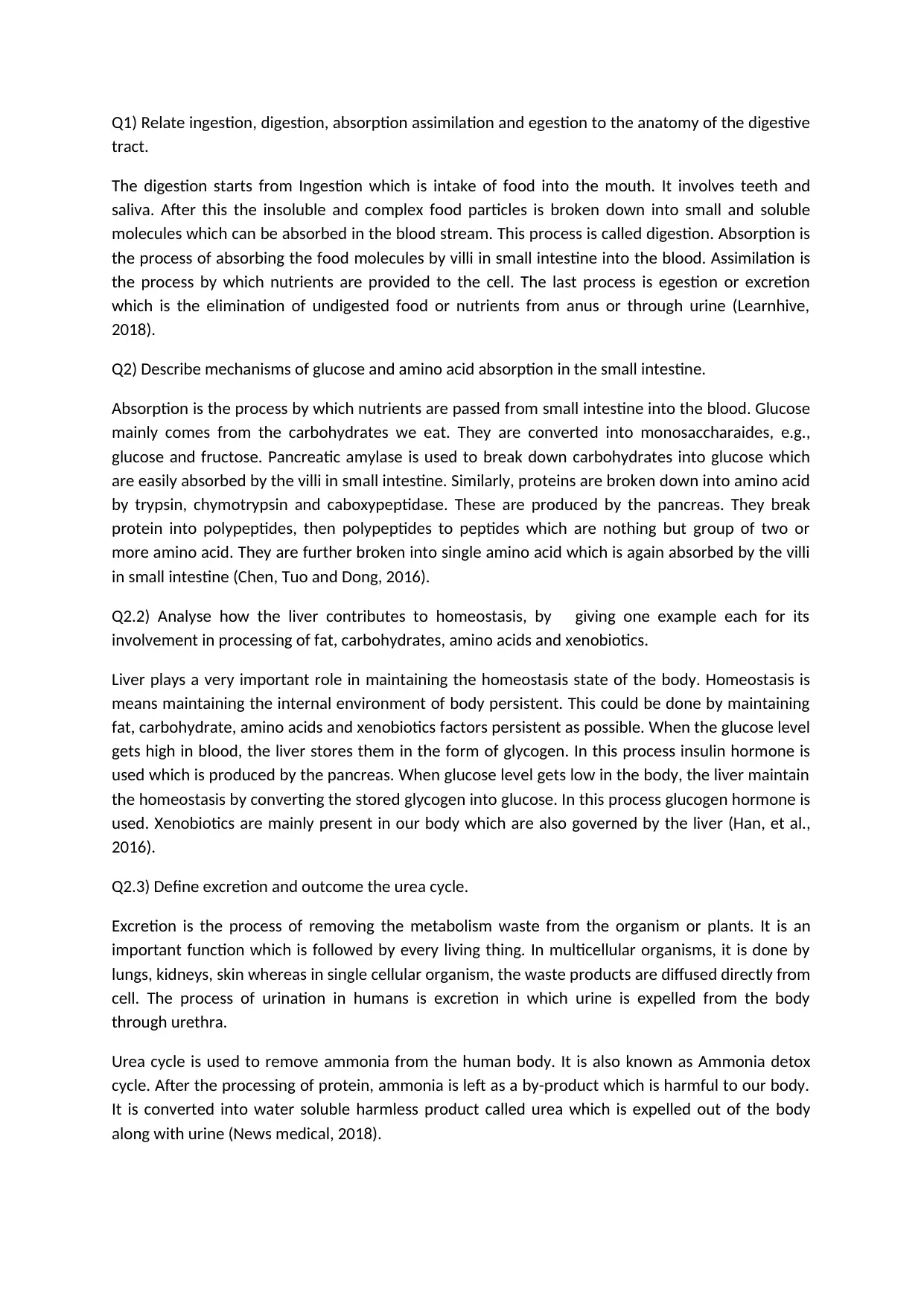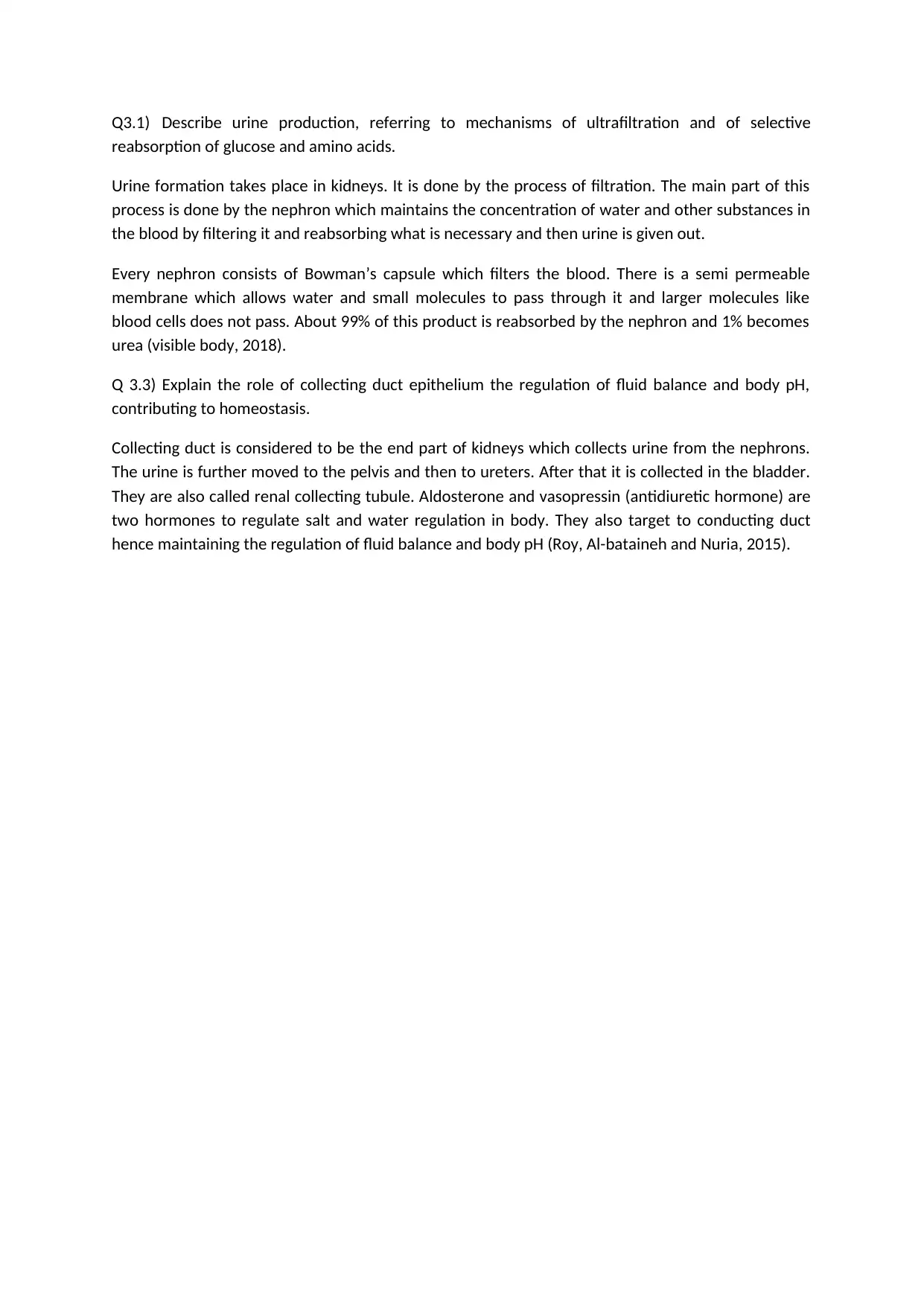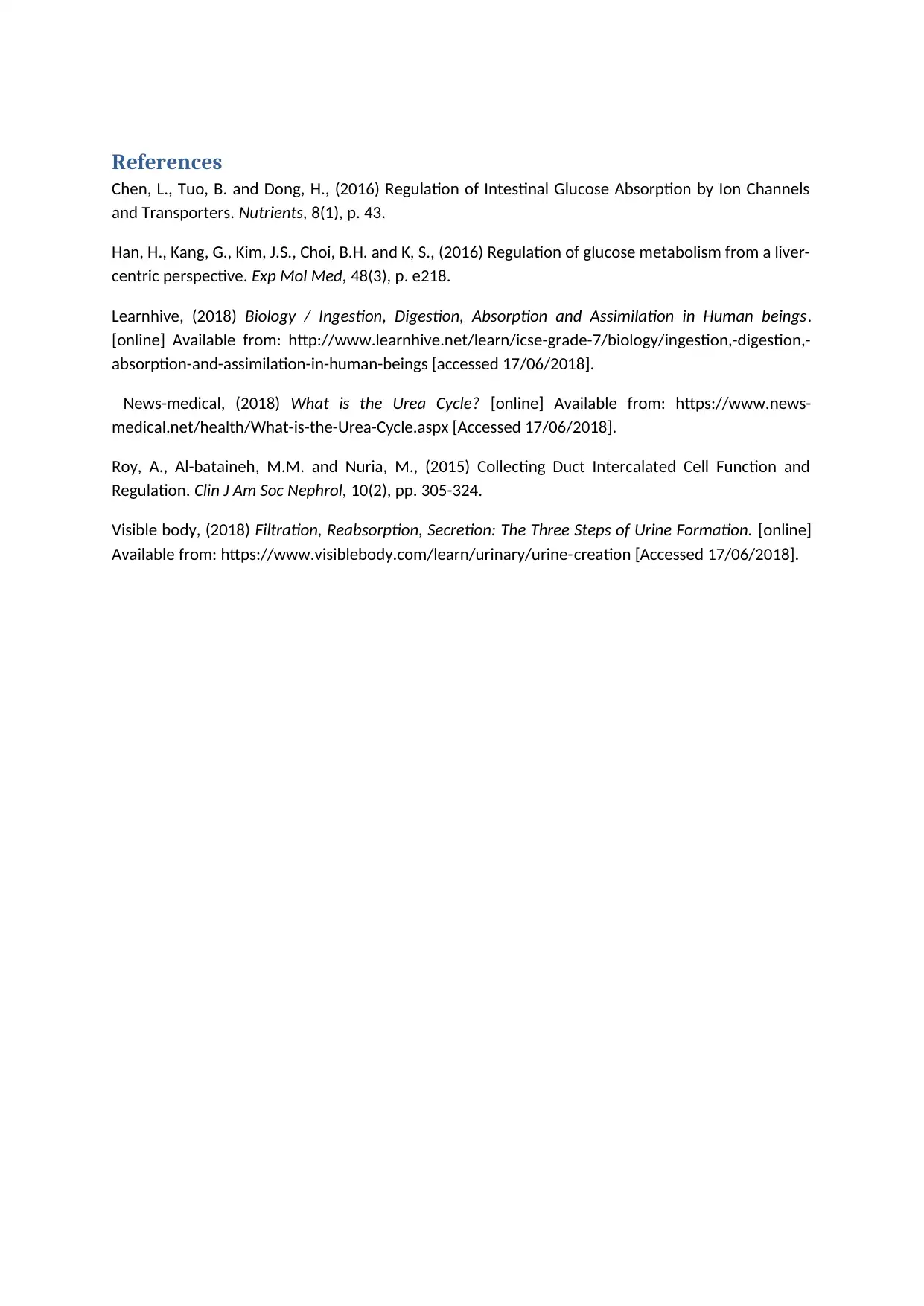Digestion, Liver Homeostasis & Urine Production in Human Body
VerifiedAdded on 2023/06/11
|3
|1055
|352
Homework Assignment
AI Summary
This assignment delves into the human digestive system, elucidating the processes of ingestion, digestion, absorption, assimilation, and egestion in relation to the anatomy of the digestive tract. It describes the mechanisms of glucose and amino acid absorption in the small intestine and analyzes the liver's contribution to homeostasis through its involvement in processing fats, carbohydrates, amino acids, and xenobiotics, also defining excretion and outlining the urea cycle. Furthermore, the assignment details urine production, referring to ultrafiltration and selective reabsorption, and explains the role of the collecting duct epithelium in regulating fluid balance and body pH, all contributing to homeostasis. Desklib provides access to similar solved assignments and past papers for students.

Q1) Relate ingestion, digestion, absorption assimilation and egestion to the anatomy of the digestive
tract.
The digestion starts from Ingestion which is intake of food into the mouth. It involves teeth and
saliva. After this the insoluble and complex food particles is broken down into small and soluble
molecules which can be absorbed in the blood stream. This process is called digestion. Absorption is
the process of absorbing the food molecules by villi in small intestine into the blood. Assimilation is
the process by which nutrients are provided to the cell. The last process is egestion or excretion
which is the elimination of undigested food or nutrients from anus or through urine (Learnhive,
2018).
Q2) Describe mechanisms of glucose and amino acid absorption in the small intestine.
Absorption is the process by which nutrients are passed from small intestine into the blood. Glucose
mainly comes from the carbohydrates we eat. They are converted into monosaccharaides, e.g.,
glucose and fructose. Pancreatic amylase is used to break down carbohydrates into glucose which
are easily absorbed by the villi in small intestine. Similarly, proteins are broken down into amino acid
by trypsin, chymotrypsin and caboxypeptidase. These are produced by the pancreas. They break
protein into polypeptides, then polypeptides to peptides which are nothing but group of two or
more amino acid. They are further broken into single amino acid which is again absorbed by the villi
in small intestine (Chen, Tuo and Dong, 2016).
Q2.2) Analyse how the liver contributes to homeostasis, by giving one example each for its
involvement in processing of fat, carbohydrates, amino acids and xenobiotics.
Liver plays a very important role in maintaining the homeostasis state of the body. Homeostasis is
means maintaining the internal environment of body persistent. This could be done by maintaining
fat, carbohydrate, amino acids and xenobiotics factors persistent as possible. When the glucose level
gets high in blood, the liver stores them in the form of glycogen. In this process insulin hormone is
used which is produced by the pancreas. When glucose level gets low in the body, the liver maintain
the homeostasis by converting the stored glycogen into glucose. In this process glucogen hormone is
used. Xenobiotics are mainly present in our body which are also governed by the liver (Han, et al.,
2016).
Q2.3) Define excretion and outcome the urea cycle.
Excretion is the process of removing the metabolism waste from the organism or plants. It is an
important function which is followed by every living thing. In multicellular organisms, it is done by
lungs, kidneys, skin whereas in single cellular organism, the waste products are diffused directly from
cell. The process of urination in humans is excretion in which urine is expelled from the body
through urethra.
Urea cycle is used to remove ammonia from the human body. It is also known as Ammonia detox
cycle. After the processing of protein, ammonia is left as a by-product which is harmful to our body.
It is converted into water soluble harmless product called urea which is expelled out of the body
along with urine (News medical, 2018).
tract.
The digestion starts from Ingestion which is intake of food into the mouth. It involves teeth and
saliva. After this the insoluble and complex food particles is broken down into small and soluble
molecules which can be absorbed in the blood stream. This process is called digestion. Absorption is
the process of absorbing the food molecules by villi in small intestine into the blood. Assimilation is
the process by which nutrients are provided to the cell. The last process is egestion or excretion
which is the elimination of undigested food or nutrients from anus or through urine (Learnhive,
2018).
Q2) Describe mechanisms of glucose and amino acid absorption in the small intestine.
Absorption is the process by which nutrients are passed from small intestine into the blood. Glucose
mainly comes from the carbohydrates we eat. They are converted into monosaccharaides, e.g.,
glucose and fructose. Pancreatic amylase is used to break down carbohydrates into glucose which
are easily absorbed by the villi in small intestine. Similarly, proteins are broken down into amino acid
by trypsin, chymotrypsin and caboxypeptidase. These are produced by the pancreas. They break
protein into polypeptides, then polypeptides to peptides which are nothing but group of two or
more amino acid. They are further broken into single amino acid which is again absorbed by the villi
in small intestine (Chen, Tuo and Dong, 2016).
Q2.2) Analyse how the liver contributes to homeostasis, by giving one example each for its
involvement in processing of fat, carbohydrates, amino acids and xenobiotics.
Liver plays a very important role in maintaining the homeostasis state of the body. Homeostasis is
means maintaining the internal environment of body persistent. This could be done by maintaining
fat, carbohydrate, amino acids and xenobiotics factors persistent as possible. When the glucose level
gets high in blood, the liver stores them in the form of glycogen. In this process insulin hormone is
used which is produced by the pancreas. When glucose level gets low in the body, the liver maintain
the homeostasis by converting the stored glycogen into glucose. In this process glucogen hormone is
used. Xenobiotics are mainly present in our body which are also governed by the liver (Han, et al.,
2016).
Q2.3) Define excretion and outcome the urea cycle.
Excretion is the process of removing the metabolism waste from the organism or plants. It is an
important function which is followed by every living thing. In multicellular organisms, it is done by
lungs, kidneys, skin whereas in single cellular organism, the waste products are diffused directly from
cell. The process of urination in humans is excretion in which urine is expelled from the body
through urethra.
Urea cycle is used to remove ammonia from the human body. It is also known as Ammonia detox
cycle. After the processing of protein, ammonia is left as a by-product which is harmful to our body.
It is converted into water soluble harmless product called urea which is expelled out of the body
along with urine (News medical, 2018).
Paraphrase This Document
Need a fresh take? Get an instant paraphrase of this document with our AI Paraphraser

Q3.1) Describe urine production, referring to mechanisms of ultrafiltration and of selective
reabsorption of glucose and amino acids.
Urine formation takes place in kidneys. It is done by the process of filtration. The main part of this
process is done by the nephron which maintains the concentration of water and other substances in
the blood by filtering it and reabsorbing what is necessary and then urine is given out.
Every nephron consists of Bowman’s capsule which filters the blood. There is a semi permeable
membrane which allows water and small molecules to pass through it and larger molecules like
blood cells does not pass. About 99% of this product is reabsorbed by the nephron and 1% becomes
urea (visible body, 2018).
Q 3.3) Explain the role of collecting duct epithelium the regulation of fluid balance and body pH,
contributing to homeostasis.
Collecting duct is considered to be the end part of kidneys which collects urine from the nephrons.
The urine is further moved to the pelvis and then to ureters. After that it is collected in the bladder.
They are also called renal collecting tubule. Aldosterone and vasopressin (antidiuretic hormone) are
two hormones to regulate salt and water regulation in body. They also target to conducting duct
hence maintaining the regulation of fluid balance and body pH (Roy, Al-bataineh and Nuria, 2015).
reabsorption of glucose and amino acids.
Urine formation takes place in kidneys. It is done by the process of filtration. The main part of this
process is done by the nephron which maintains the concentration of water and other substances in
the blood by filtering it and reabsorbing what is necessary and then urine is given out.
Every nephron consists of Bowman’s capsule which filters the blood. There is a semi permeable
membrane which allows water and small molecules to pass through it and larger molecules like
blood cells does not pass. About 99% of this product is reabsorbed by the nephron and 1% becomes
urea (visible body, 2018).
Q 3.3) Explain the role of collecting duct epithelium the regulation of fluid balance and body pH,
contributing to homeostasis.
Collecting duct is considered to be the end part of kidneys which collects urine from the nephrons.
The urine is further moved to the pelvis and then to ureters. After that it is collected in the bladder.
They are also called renal collecting tubule. Aldosterone and vasopressin (antidiuretic hormone) are
two hormones to regulate salt and water regulation in body. They also target to conducting duct
hence maintaining the regulation of fluid balance and body pH (Roy, Al-bataineh and Nuria, 2015).

References
Chen, L., Tuo, B. and Dong, H., (2016) Regulation of Intestinal Glucose Absorption by Ion Channels
and Transporters. Nutrients, 8(1), p. 43.
Han, H., Kang, G., Kim, J.S., Choi, B.H. and K, S., (2016) Regulation of glucose metabolism from a liver-
centric perspective. Exp Mol Med, 48(3), p. e218.
Learnhive, (2018) Biology / Ingestion, Digestion, Absorption and Assimilation in Human beings.
[online] Available from: http://www.learnhive.net/learn/icse-grade-7/biology/ingestion,-digestion,-
absorption-and-assimilation-in-human-beings [accessed 17/06/2018].
News-medical, (2018) What is the Urea Cycle? [online] Available from: https://www.news-
medical.net/health/What-is-the-Urea-Cycle.aspx [Accessed 17/06/2018].
Roy, A., Al-bataineh, M.M. and Nuria, M., (2015) Collecting Duct Intercalated Cell Function and
Regulation. Clin J Am Soc Nephrol, 10(2), pp. 305-324.
Visible body, (2018) Filtration, Reabsorption, Secretion: The Three Steps of Urine Formation. [online]
Available from: https://www.visiblebody.com/learn/urinary/urine-creation [Accessed 17/06/2018].
Chen, L., Tuo, B. and Dong, H., (2016) Regulation of Intestinal Glucose Absorption by Ion Channels
and Transporters. Nutrients, 8(1), p. 43.
Han, H., Kang, G., Kim, J.S., Choi, B.H. and K, S., (2016) Regulation of glucose metabolism from a liver-
centric perspective. Exp Mol Med, 48(3), p. e218.
Learnhive, (2018) Biology / Ingestion, Digestion, Absorption and Assimilation in Human beings.
[online] Available from: http://www.learnhive.net/learn/icse-grade-7/biology/ingestion,-digestion,-
absorption-and-assimilation-in-human-beings [accessed 17/06/2018].
News-medical, (2018) What is the Urea Cycle? [online] Available from: https://www.news-
medical.net/health/What-is-the-Urea-Cycle.aspx [Accessed 17/06/2018].
Roy, A., Al-bataineh, M.M. and Nuria, M., (2015) Collecting Duct Intercalated Cell Function and
Regulation. Clin J Am Soc Nephrol, 10(2), pp. 305-324.
Visible body, (2018) Filtration, Reabsorption, Secretion: The Three Steps of Urine Formation. [online]
Available from: https://www.visiblebody.com/learn/urinary/urine-creation [Accessed 17/06/2018].
⊘ This is a preview!⊘
Do you want full access?
Subscribe today to unlock all pages.

Trusted by 1+ million students worldwide
1 out of 3
Related Documents
Your All-in-One AI-Powered Toolkit for Academic Success.
+13062052269
info@desklib.com
Available 24*7 on WhatsApp / Email
![[object Object]](/_next/static/media/star-bottom.7253800d.svg)
Unlock your academic potential
Copyright © 2020–2025 A2Z Services. All Rights Reserved. Developed and managed by ZUCOL.





